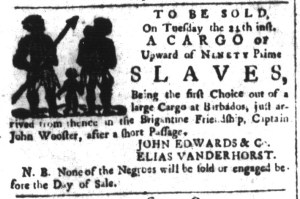GUEST CURATOR: J. Rioux
Who was the subject of an advertisement in a colonial American newspaper 250 years ago today?

“A CARGO OF Upward of NINETY Prime SLAVES.”
Advertisements in early American newspapers contain some of the most degrading language used towards fellow human beings. On December 16, 1771, the South-Carolina and American General Gazette published a listing for a large group of enslaved people to be sold, likely by auction. John Edwards and Company and Elias Vanderhorst stated, “To be sold … A CARGO of Upward NINETY Prime SLAVES, Being the first Choice out of a large Cargo at Barbados.” This choice of words signals to modern readers that racism was embedded in the United States from the very beginning.
The words “Choice” and “Prime” was often used in regards to goods. In essence, these men, women, and children were being described as objects, as commodities. The language in this advertisement stripped them of their identities, demonstrating that some people were valued less than others. This is contradictory to precious words written during the same era: “We hold these truths to be self-evident, that all men are created equal, that they are endowed by their Creator with certain unalienable Rights, that among these are Life, Liberty and the pursuit of Happiness.” Thomas Jefferson wrote those words less than five years after the men, women, and children in this “CARGO” were deprived of their liberty.
John Cheng, a historian who teaches at George Mason University, declares, “‘Race” explained why Africans were slaves, while slavery’s degradation supplied the evidence for their inferiority.” The repercussions of such ideology continue today as Black Lives Matter and other organizations have emerged to address the ongoing dehumanization that too often takes place in American society.
**********
ADDITIONAL COMMENTARY: Carl Robert Keyes
Rioux, as he prefers to be called, completed this entry in the spring of 2021 when he enrolled in my research methods class, a course required of all History majors before they take the capstone research seminar in their senior year. In addition to selecting an advertisement to feature for the Adverts 250 Project, he also served as the guest curator for the Slavery Adverts 250 Project this week. This advertisement about a “CARGO OF … Prime SLAVES” is one of the sixty-one advertisements about enslaved men, women, and children that appeared in colonial American newspapers from New England to South Carolina during the week of December 12-18, 1771. His classmates all undertook the same assignments: select one advertisement to feature on the Adverts 250 Project (not necessarily about slavery) and serve as guest curator of the Slavery Adverts 250 Project for a week. I incorporated the same assignments into my Revolutionary America, 1763-1815, class this semester.
I’m preparing Rioux’s entry for publication and writing my own commentary on the same day that I have devoted many hours to grading final projects for my Revolutionary America course. Many students confess to some initial trepidation about taking on these responsibilities when I first introduce the projects in class. After all, these are not the essays that they expected to write in a history class. Like Rioux, however, they become proficient at using databases of digitized eighteenth-century newspapers, identifying advertisements that belong in the project, and placing them in historical context. That they examine so many advertisements about enslaved men, women, and children certainly has an impact, much more than when I supplied representative examples for consideration during lectures and discussion. Encountering the advertisements in the original sources, seeing their frequency and their proximity to other contents of early American newspapers, helps my students understand the ubiquity of notices presenting enslaved people for sale or offering rewards for the capture and return of those who liberated themselves. When they do the research themselves, it becomes impossible for my students not to recognize how entrenched slavery was in everyday life throughout the colonies during the era of the American Revolution. Books, articles, and lectures make the same point, but many of my students report that it becomes more real when they see it for themselves as they examine newspapers from the period. This also allows them to reach their own conclusions as they test the arguments made by historians against what they find in original sources from early America.
